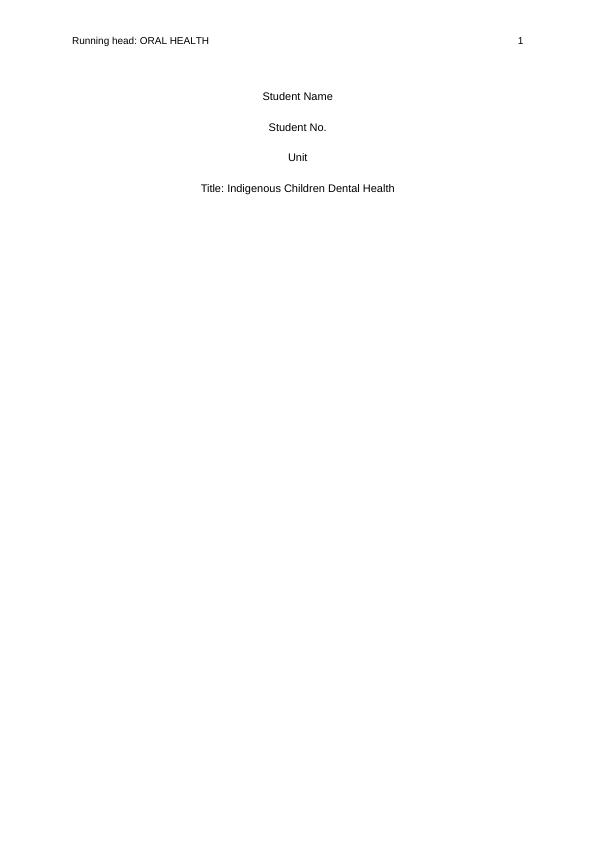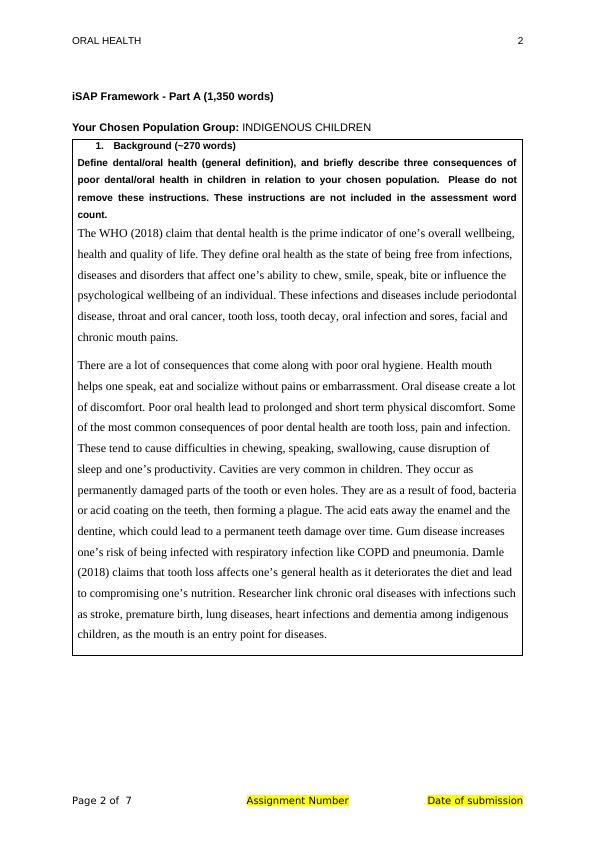Indigenous Children Dental Health
Added on 2022-11-28
7 Pages2360 Words455 Views
Running head: ORAL HEALTH 1
Student Name
Student No.
Unit
Title: Indigenous Children Dental Health
Student Name
Student No.
Unit
Title: Indigenous Children Dental Health

ORAL HEALTH 2
iSAP Framework - Part A (1,350 words)
Your Chosen Population Group: INDIGENOUS CHILDREN
1. Background (~270 words)
Define dental/oral health (general definition), and briefly describe three consequences of
poor dental/oral health in children in relation to your chosen population. Please do not
remove these instructions. These instructions are not included in the assessment word
count.
The WHO (2018) claim that dental health is the prime indicator of one’s overall wellbeing,
health and quality of life. They define oral health as the state of being free from infections,
diseases and disorders that affect one’s ability to chew, smile, speak, bite or influence the
psychological wellbeing of an individual. These infections and diseases include periodontal
disease, throat and oral cancer, tooth loss, tooth decay, oral infection and sores, facial and
chronic mouth pains.
There are a lot of consequences that come along with poor oral hygiene. Health mouth
helps one speak, eat and socialize without pains or embarrassment. Oral disease create a lot
of discomfort. Poor oral health lead to prolonged and short term physical discomfort. Some
of the most common consequences of poor dental health are tooth loss, pain and infection.
These tend to cause difficulties in chewing, speaking, swallowing, cause disruption of
sleep and one’s productivity. Cavities are very common in children. They occur as
permanently damaged parts of the tooth or even holes. They are as a result of food, bacteria
or acid coating on the teeth, then forming a plague. The acid eats away the enamel and the
dentine, which could lead to a permanent teeth damage over time. Gum disease increases
one’s risk of being infected with respiratory infection like COPD and pneumonia. Damle
(2018) claims that tooth loss affects one’s general health as it deteriorates the diet and lead
to compromising one’s nutrition. Researcher link chronic oral diseases with infections such
as stroke, premature birth, lung diseases, heart infections and dementia among indigenous
children, as the mouth is an entry point for diseases.
Page 2 of 7 Assignment Number Date of submission
iSAP Framework - Part A (1,350 words)
Your Chosen Population Group: INDIGENOUS CHILDREN
1. Background (~270 words)
Define dental/oral health (general definition), and briefly describe three consequences of
poor dental/oral health in children in relation to your chosen population. Please do not
remove these instructions. These instructions are not included in the assessment word
count.
The WHO (2018) claim that dental health is the prime indicator of one’s overall wellbeing,
health and quality of life. They define oral health as the state of being free from infections,
diseases and disorders that affect one’s ability to chew, smile, speak, bite or influence the
psychological wellbeing of an individual. These infections and diseases include periodontal
disease, throat and oral cancer, tooth loss, tooth decay, oral infection and sores, facial and
chronic mouth pains.
There are a lot of consequences that come along with poor oral hygiene. Health mouth
helps one speak, eat and socialize without pains or embarrassment. Oral disease create a lot
of discomfort. Poor oral health lead to prolonged and short term physical discomfort. Some
of the most common consequences of poor dental health are tooth loss, pain and infection.
These tend to cause difficulties in chewing, speaking, swallowing, cause disruption of
sleep and one’s productivity. Cavities are very common in children. They occur as
permanently damaged parts of the tooth or even holes. They are as a result of food, bacteria
or acid coating on the teeth, then forming a plague. The acid eats away the enamel and the
dentine, which could lead to a permanent teeth damage over time. Gum disease increases
one’s risk of being infected with respiratory infection like COPD and pneumonia. Damle
(2018) claims that tooth loss affects one’s general health as it deteriorates the diet and lead
to compromising one’s nutrition. Researcher link chronic oral diseases with infections such
as stroke, premature birth, lung diseases, heart infections and dementia among indigenous
children, as the mouth is an entry point for diseases.
Page 2 of 7 Assignment Number Date of submission

ORAL HEALTH 3
2. Assessment of Poster (~270 words)
Critically analyse the poster (strengths and weaknesses) in relation to your chosen
population and briefly discuss three possible barriers to implementing the suggested dental
hygiene practices. Please do not remove these instructions. These instructions are not
included in the assessment word count.
According to the poster, pea sized amount of fluoride tooth paste and a small head soft
brush should be used. The tooth paste should have a low concentration of fluorine. While
aiming the toothbrush to an angle, jiggle it and move it in small circles over the teeth and
the gum. Epstein (2018) thinks that this is right way for children to brush their teeth.
However, caution should be taken when jiggling the toothbrush on the gum. The children
gums are very tender and could be hurt easily. This is also the reason as to why a soft brush
is recommended. According to Wright et al. (2014) fluoride is thought to cause dental
fluorosis among young children, and that’s why it is recommended to use toothpaste size of
rice grain for children. This poster has not touched on how to minimize swallowing of the
paste. Wright et al. (2014) claim it could be dangerous. They recommend angling of the
child’s head downward so that the extra toothpaste dribbles out of the mouth.
Pesaressi, Villena, van der Sanden, Mulder and Frencken (2014) children rarely visit the
dentist due to cultural and country dependent factors. Children only visit the hospitals for
vaccination and advice on their health. Pesaressi et al. (2014) claim that another factor
contributing to poor dental hygiene practices among the aboriginal children is lack of
training for the nurses on children oral health care. If they are trained, they would in turn
train parents and caregivers on oral health behaviours, their importance and also how to
detect oral infections among the children. Nes and Reis (2018) argue that poor oral health
among aboriginal children is as a result of frequent consumption of sugar, poor oral
hygiene and failure to use fluoride. They link these to economic, social and environmental
factors.
Page 3 of 7 Assignment Number Date of submission
2. Assessment of Poster (~270 words)
Critically analyse the poster (strengths and weaknesses) in relation to your chosen
population and briefly discuss three possible barriers to implementing the suggested dental
hygiene practices. Please do not remove these instructions. These instructions are not
included in the assessment word count.
According to the poster, pea sized amount of fluoride tooth paste and a small head soft
brush should be used. The tooth paste should have a low concentration of fluorine. While
aiming the toothbrush to an angle, jiggle it and move it in small circles over the teeth and
the gum. Epstein (2018) thinks that this is right way for children to brush their teeth.
However, caution should be taken when jiggling the toothbrush on the gum. The children
gums are very tender and could be hurt easily. This is also the reason as to why a soft brush
is recommended. According to Wright et al. (2014) fluoride is thought to cause dental
fluorosis among young children, and that’s why it is recommended to use toothpaste size of
rice grain for children. This poster has not touched on how to minimize swallowing of the
paste. Wright et al. (2014) claim it could be dangerous. They recommend angling of the
child’s head downward so that the extra toothpaste dribbles out of the mouth.
Pesaressi, Villena, van der Sanden, Mulder and Frencken (2014) children rarely visit the
dentist due to cultural and country dependent factors. Children only visit the hospitals for
vaccination and advice on their health. Pesaressi et al. (2014) claim that another factor
contributing to poor dental hygiene practices among the aboriginal children is lack of
training for the nurses on children oral health care. If they are trained, they would in turn
train parents and caregivers on oral health behaviours, their importance and also how to
detect oral infections among the children. Nes and Reis (2018) argue that poor oral health
among aboriginal children is as a result of frequent consumption of sugar, poor oral
hygiene and failure to use fluoride. They link these to economic, social and environmental
factors.
Page 3 of 7 Assignment Number Date of submission

End of preview
Want to access all the pages? Upload your documents or become a member.
Related Documents
Oral Health among Indigenous Australians PowerPoint Presentation 2022lg...
|12
|1036
|8
HLT54115 Diploma of Nursing Assignmentlg...
|5
|1848
|156
Oral Health among Indigenous Australians Issue 2022lg...
|8
|2214
|14
DN15lg...
|6
|1753
|62
Oral and Dental Diseases : Assignmentlg...
|9
|2894
|230
Dental Hygiene in Childrenlg...
|9
|2189
|233
